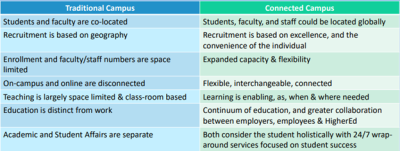Blended and hybrid learning has indefinitely altered the way higher education teaches and communicates with students and faculty. As a result, the concept of the Connected Campus and allowing secure, unrestricted access at any time is becoming more of a reality than ever before.
Vistasp Karbhari, former President and Professor at the Department of Mechanical and Aerospace Engineering and Department of Civil Engineering at The University of Texas at Arlington, recently gave a presentation on what truly defines a “Connected Campus” and how higher education institutions are evolving quickly.
According to Karbhari, a Connected Campus is an evolution in space and location. Traditionally, university and college campuses are limited to a physical space, to a particular geographic location. In order for students to partake in learning at the institution, they had to be at a specific place at a specific time. Karbhari encourages higher education leaders to reconsider how to connect with students, rethinking the traditional constraints of time and space and brainstorming ways in which connectivity can be geographically and temporally unconstrained. By doing this, educators can then work towards an evolution in how knowledge is disseminated, moving from the focus of bringing students to campus to enabling learners to access knowledge wherever they may be.
Conventionally, space and location has shaped campus community and identity. But the evolving campus, the Connected Campus, can broaden our definitions of space and release the constraints previously in place, embracing a "phygital" environment. Becoming a Connected Campus increases engagement and enhances equity among students and faculty. Bridging the gap between the physical learning environment and digital learning is the future of education.
The table below illustrated the ways in which the traditional campus and the Connected Campus differ:

The difference is between a campus that is data driven and a campus that is data inspired. Advising offices on traditional campuses are typically only open during normal business hours and have long wait times. Students often feel as though advising is reactive and punitive, causing them to feel isolated and separated from academic affairs. On the contrary, advising on a Connected Campus can be available 24/7 and can partner with students on their academic journey, being proactive and enabling students to reach their potential.
A Connected Campus
- Makes geographical location immaterial (students, faculty, & staff)
- Dramatically changes the scope of “student” and “faculty”
- Catalyzes knowledge availability on demand (from modules to entire programs)
- Enables transition from teaching to learning & listening to doing
- Enables insight driven guidance and success of students (holistic) 24/7/365
- Provides faculty with tools & mechanisms for local and global engagement
- Fosters dynamic (not just transactional) engagement at all levels
- Enables delivery of new modes of interaction/transactions while strengthening existing ones
- Fosters a “data inspired” culture through real time availability of data/analysis
- Provides contextual information based on need for operations
- Improves operational efficiency & leverages EdTech & innovations from other sectors
- Improves sociological contexts – communications, belonging, support
The future of higher education is the combination of physical space and integrated digital platforms with the focus being on the students and faculty. This enables people to be spread across the globe by accessing information and services seamlessly. Leaders in higher education must plan physically, creating a thriving learning environment that is unconstrained by time, space, and location.
Fierce Education will be holding its own virtual summit on the "Connected Campus" on August 25, 2022. Click here for more information.